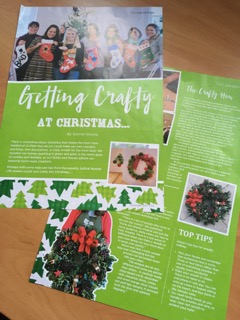Getting Crafty for Christmas
There is something about Christmas that makes the most cack-handed of us think that we too could make our own crackers, stockings, tree decorations, or holly wreath for the front door. We visualise our homes sparkling in green and gold, in the warm glow of candles and firelight, as our family and friends admire our seasonal hand-made creations.
Perhaps with some help and tips from the experts, Suffolk Norfolk Life readers could turn crafty this Christmas .
Linda Bloomfield from Capel St Mary in Suffolk, runs craft sessions for clubs and organisations such as Women’s Institutes and retirement homes. She teaches men and women to make many different types of Christmas decorations: fabric wreaths on a polystyrene base, baubles to hang on the tree, and fir-cone gnomes.
Linda has boxes of cards she has made, that she sells to raise money for EACH, and she reckons that Christmas cards are the easiest thing for a beginner to make.
Cards are easy for anyone to have a go at – you just cut things out and stick them on. You can make cards out of anything, even buttons. Luckily Christmas has nice easy shapes – a triangle for a tree or a circle for a wreath or a robin, she reassured.
Working with men is particularly good, as most of them have never done it before. They are also good at following instructions. Give them glue and pretty stuff and they go bananas!
What are the common mistakes people make when they start card making?
“I think they get too ambitious. Simple is more effective. Also, if you make the card too big or too heavy they are expensive to post. The ones made from buttons are a good example. They would probably be best for hand-delivered cards.”
So where can people get ideas for cards?
“There are two television channels for crafters and they broadcast all day, with many of the programmes about card-making.”
Linda’s top tips for card-making:
- Keep your design simple
- Buy good quality cards (they are easily available from local craft shops or online)
- Make sure your card will fit into decent envelope.
The Crafty Hen, runs craft sessions across the country for hen-dos with a difference, and they also offer Christmas Workshops. (http://www.thecraftyhen.co.uk)
“I was running craft classes in my own area, and my parties for brides, and their family and friends, became so popular that I now have a team of trainers covering the country,” explained founder and ‘Head Hen’, Julie Roberts. “In Norfolk and Suffolk, we have mainly held pre-wedding hen parties where all the generations come together, but we also do team building workshops too.”
The trainers are all artists and craft makers in their own right, who also enjoy passing on the skills at the very informal sessions. What are the most popular of the Christmas workshops? Christmas tree decorations….
“Probably painting ceramic Christmas decorations and sewing handmade felt tree decorations. Some people have never sewn in their lives so we even have to teach them how to thread a needle, but others are more experienced sewers and learn new techniques and ideas at the session.”
At hen parties, Christmas knickers are a popular “make”, but participants can also make paper crackers and felt Santa stockings, if that is too raunchy!
Julie’s top tips for Christmas decoration making?
- Do something that really appeals to you. You can get ideas from craft shops and the internet.
- Have a go. It’s never as scary as you think.
- Join a class and get directions from an expert.
When it comes to making a Christmas holly wreath for the front door, it was time to get some advice from Alison Cooper who teaches floristry at Easton College, Norfolk, and will lead a very popular holly wreath workshop this December.
“There is a mix of people who come to the one day course.,” she explained. “Some are already creative and just like some guidance, while others are new to holly wreaths. There is a real sense of fulfilment when you make a wreath of your own design for your front door, to greet your guests.”
Alison says that a holly wreath may look challenging but the process can be broken down into easy steps.
“The designs are all very different and some are glitzier than others. A carefully made moss-based circle, decorated with cinnamon sticks, cones, and dried orange slices should last until late January, if removed from the door and watered regularly.”
Alison’s top tips for wreath-making:
1. Plan your theme and remember that sometimes less is more. Three or four items rather than one of everything possible, is usually more successful.
2. Make your wreath in stages. There is no need to do everything in one day. You can wire up cones in August, sitting on the beach, and buy items in the January sales.
3. You need hardy hands as you handle the prickles and wire, so wear clear nail varnish to protect your nails!
Forget your memories of playgroup nativity scenes made from shoeboxes, or Blue Peter Advent Crowns, it is now easy to get quality materials so even beginners’ home-made Christmas decorations look as good, if not better, than those available to buy in a shop. It may not be cheaper that buying ‘off the peg’, but it must be much more satisfying to create something with your own unique style.
Finally, I ended my research by entering “Making Christmas Decorations” into my favourite search engine… and got 22,600,000 results! So, there is no excuse! Now, where are my scissors and glue…….
(This article first appeared in Suffolk Norfolk Life magazne in December 2017.)
